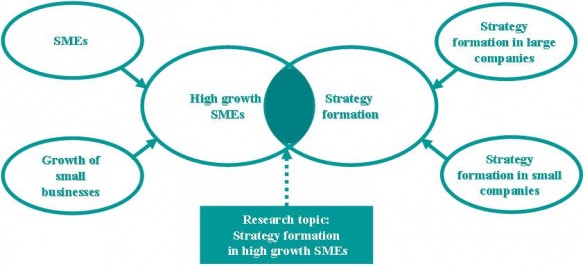Strategy formation in high growth SMEs
Small and medium sized companies (SMEs) represent an important component of the wealth creation of a nation. A large number of new businesses are born every year; however, only a limited number of them survive and manage to deliver sustainable growth and, thus, contribute to a nation’s output and employment generation. Therefore, it is critical to understand whether and how paths of high growth SMEs are carefully crafted and planned from early stages:
- How does a process of strategy formation in high growth SMEs takes place and develop?
- Which are catalysts and barriers to a process of strategy formation in high growth SMEs?
Research aims
The main research topic of this paper is to understand how strategy is formed and how strategy formation develops in high growth SMEs. This research will follow an exploratory approach and aims:
- to understand how strategy is formed in high growth SMEs
- to develop a framework of a process of strategy formation in high growth SMEs
- to identify factors encountered in the strategy formation process and classify them as catalysts or barriers
The research topic lies at the intersection of two research areas: high growth SMEs and strategy formation. This research aims to bridge a gap between these two areas and study strategy formation in high growth SMEs, which lacks a coherent theoretical framework at present and is covered by a relatively limited number of academic papers.

Current work and future research
Creating or developing strategies is “how organisations make and then interrelate their significant(that is, strategic)decisions”(Minzberg, 1978). A strategy formation framework results from empirical research and articulates a decision process in a standardised form. The idiosyncrasies of small firms could make impracticable the application of formal strategy decision making processes as used by large firms to small firms (Liberman-Yaconi et al., 2010).
To develop a framework of a strategy formation in high growth SMEs, this research’s design is predicated on a case study methodology.
A matrix of criteria has been defined for the selection of the companies to be studied in line with the findings of the existing literature. High-growth small firms share common characteristics: they survive the first five years, successfully overcome the difficulties of the early development stages, consistently deliver high-growth performance beyond the survival needs and sustain a high-growth performance to become leaders in their markets (Garnsey, 2005).
Interviews with relevant executives of sample companies will be one of the main methods of data collection and, most likely, the most relevant to this research. Interview questions will be open/semi-open ended to allow flexibility and eliminate a researcher’s biases. The design of an interview questionnaire and a framework of the strategy process encapsulating the findings of literature review are work in progress. The framework will be subsequently developed and refined based on the outcome of the analysis of data collected from the case companies.
Further information
Carmina Buzuloiu E: cb652@cam.ac.uk T: +44 (0) 1223 766141
Carmina is supervised by Dr Ken Platts, advised by Dr Tim Minshall.









